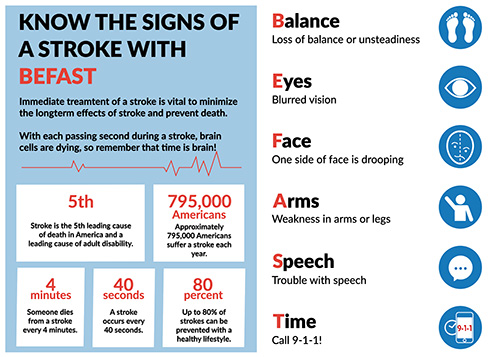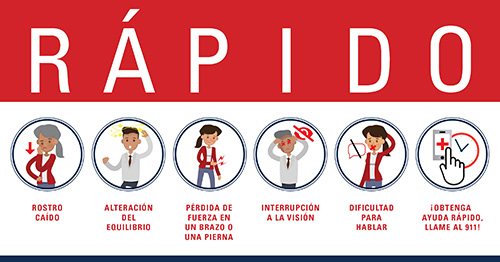
A stroke or a brain attack occurs when a blood clot blocks a blood vessel or when a blood vessel bursts, interrupting blood flow to an area of the brain. An ischemic stroke occurs when the blood vessel is blocked. This is the most common type of stroke. A hemorrhagic stroke (brain bleed) occurs when a blood vessels breaks. This type of stroke is less common.
Let's learn about Stroke
This short video explains what a stroke is, the different types (ischemic and hemorrhagic), and why quick action is critical. It also introduces the BEFAST acronym to help recognize common stroke warning signs. Watch to learn how to spot a stroke and respond fast - it could save a life.
Transient Ischemic Attack (TIA) – NOT a “mini stroke”
A transient ischemic attack (TIA) occurs when there is momentary loss of blood flow to an area of the brain. Because the blood flow is restored on its own, the symptoms of stroke go away on their own after minutes to hours. A TIA is a sign that a stroke may occur and is therefore as dangerous as a stroke. We avoid the use of the term “mini-stroke” because it minimizes the importance of a TIA. There is a high risk of stroke in the days, weeks, and months after a TIA. It is important to seek medical attention as soon as signs of the TIA occur. The signs of TIA and risk factors for TIA are the same as for stroke. A stroke can be prevented if risk factors are adequately assessed and managed after a TIA occurs.
Promoting Stroke Awareness
UTHealth Houston promotes stroke awareness by educating the public on how to recognize stroke symptoms and respond quickly. The BEFAST acronym—Balance, Eyes, Face, Arms, Speech, Time—provides a simple way to identify warning signs and seek emergency care.
To better serve the Hispanic community, UTHealth Houston introduces a new acronym—RÁPIDO—to help identify the warning signs of stroke in Spanish. Just like BEFAST, RÁPIDO is designed to make recognizing a stroke easier and faster, ensuring more lives can be saved through timely action.

World Stroke Day is October 29
Know BEFAST and Signs of a Stroke
UTHealth Houston's World Stroke Day message breaks down what a stroke is and why acting fast matters. It uses the BEFAST acronym - Balance, Eyes, Face, Arms, Speech, Time - to help people quickly spot the signs and know when to call for help. The goal is simple: save lives and reduce the impact of stroke through awareness and quick action.
-
What are the risk factors for stroke?
Risk factors are medical conditions or lifestyle practices that can increase one’s chance of having a stroke. Risk factors can be modifiable (things we can change) or non-modifiable (things we cannot change).
- Non-modificable risk factors include age, race, and gender.
- Hypertension (high blood pressure) is the most important modifiable risk factor for both types of stroke.
- Other important risk factors include tobacco use, diabetes, high cholesterol, lack of physical activity, unhealthy diet, drug use, and excess alcohol intake.
- Atrial fibrillation, an abnormal heart rhythm that causes clots to develop in the heart is another important risk factor for stroke, especially among those of older age.
Global, Regional, and Country-Specific Lifetime Risks of Stroke, 1990 and 2016
-
What are the most common stroke symptoms?
- Sudden numbness or weakness of face, arm or leg, especially on one side of the body
- Sudden confusion, trouble speaking or understanding
- Sudden trouble seeing in one or both eyes
- Sudden trouble walking, dizziness, loss of balance or coordination
- Sudden severe headache with no known cause
Other important but less common stroke symptoms:
- Sudden nausea and vomiting
- Brief loss of consciousness or period of decreased consciousness (fainting, confusion, convulsions or coma)
-
What happens to the brain when a stroke occurs?
The brain needs oxygen in the blood to survive, when the blood flow is disrupted, the cells in the part of the brain that were receiving this blood can die. These cells usually die within minutes to a few hours after the stroke starts. When cells die, chemicals are released that can cause even more cells to die. This is why there is a small window of opportunity for treatment of ischemic stroke.
The most important thing to remember is that the earlier a stroke victim gets to the emergency department, the better the chance that they will be able to receive treatment that stops or reduces the amount of brain damage from the stroke.
When brain cells die, functions that were under control of the dying brain are lost. These include functions such as language, speech, movement, and sensation. The specific abilities lost or affected depend on where in the brain the stroke occurs and on the size of the stroke.
For example, someone who has a small stroke may experience only minor effects such as weakness of an arm or leg. On the other hand, someone who has a larger stroke may be left paralyzed on one side or lose his/her ability to express and process language. Some people recover completely from less serious strokes, while other individuals lose their lives to very severe strokes.
Stroke Treatment, Prevention and Decreasing your risk
Treatment
The only FDA approved treatment for ischemic stroke is a medication called tissue plasminogen activator (tPA). This “brain saving” treatment dissolves the clot that is causing the stroke. This medication can only be given through an IV given within 4.5 hours after a stroke begins. The sooner the medicine is given, the better the chances of restoring oxygen to the dying brain in time to prevent more damage. Depending on the type of hemorrhagic (bleeding) stroke that occurs, there are different options for treatment including surgery.
Prevention
Strokes are preventable. It is estimated that up to 80% of strokes can be prevented by addressing modifiable risk factors. When a person has a stroke, their risk of having another stroke is increased. When a person is treated for a stroke, medications and recommendations are given to prevent further strokes.
Decreasing your risk
- Identify and treat high blood pressure
- Identify and treat diabetes
- Stop smoking
- Identify and treat high cholesterol
- Take blood thinners if recommended by your doctor
- Exercise regularly ( more than 30 minutes most days of the week)
- Avoid high sodium and excess fat in diet in order to maintain a healthy weight and prevent development of hypertension and diabetes
Need Stroke Care or Support?
Learn more about the stroke-related services we provide to patients and their families—from diagnosis and treatment to recovery and rehabilitation.